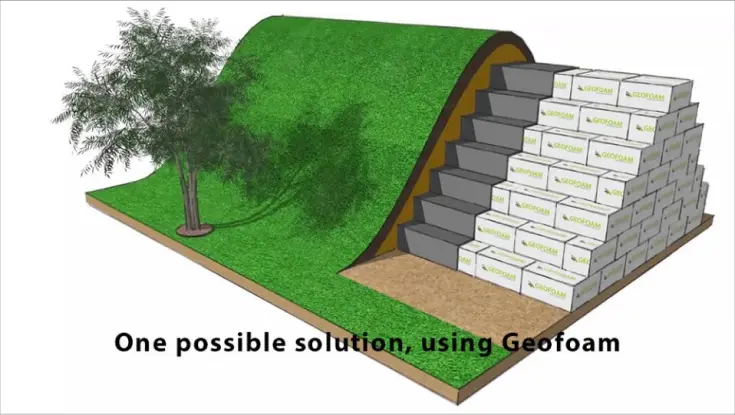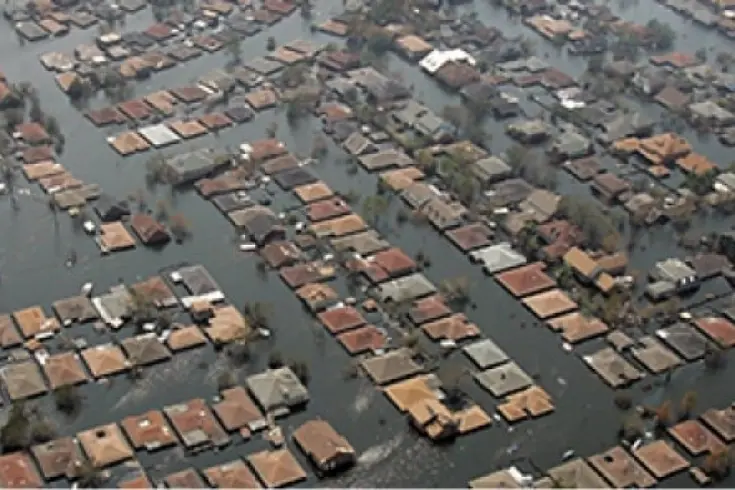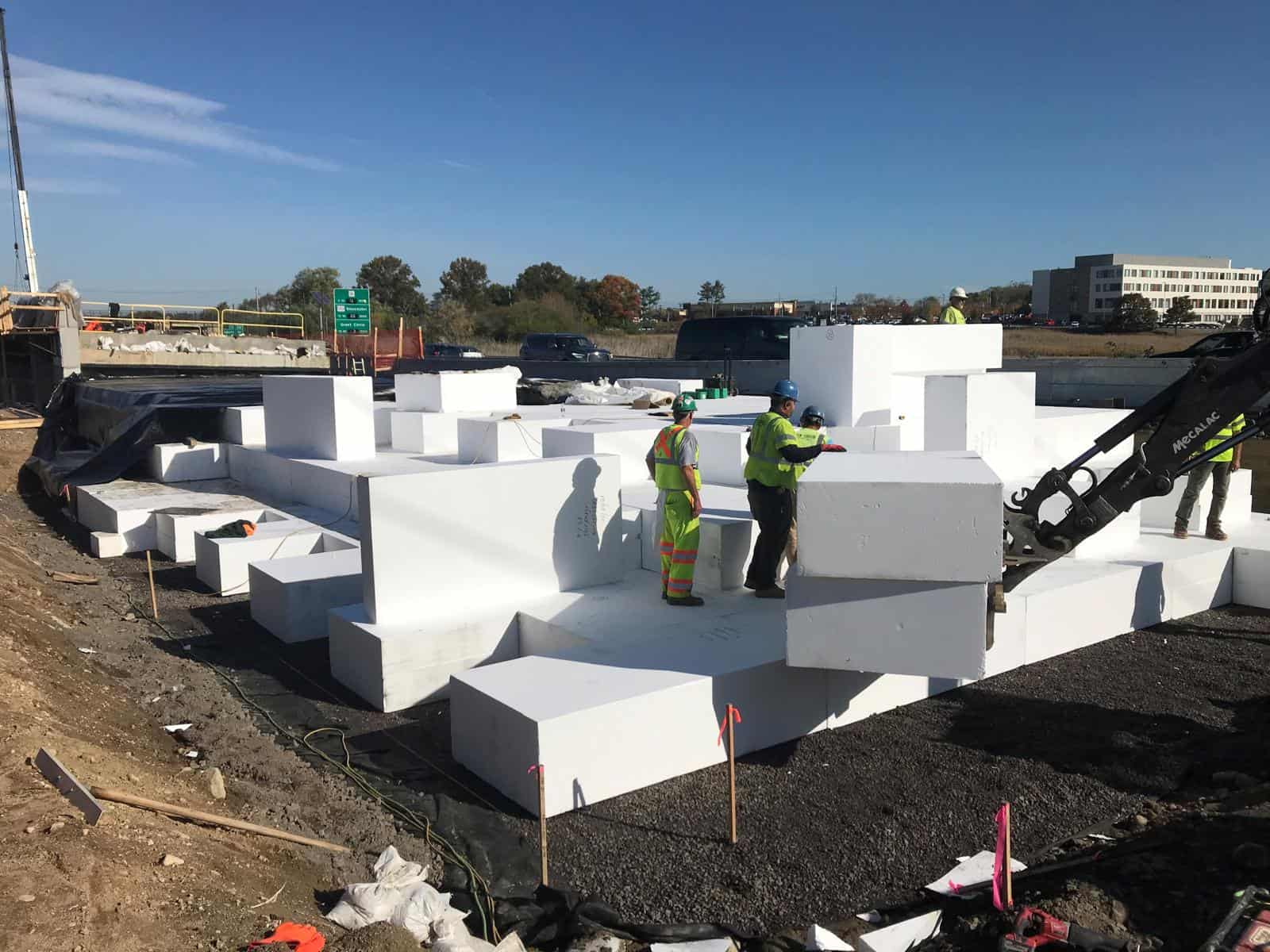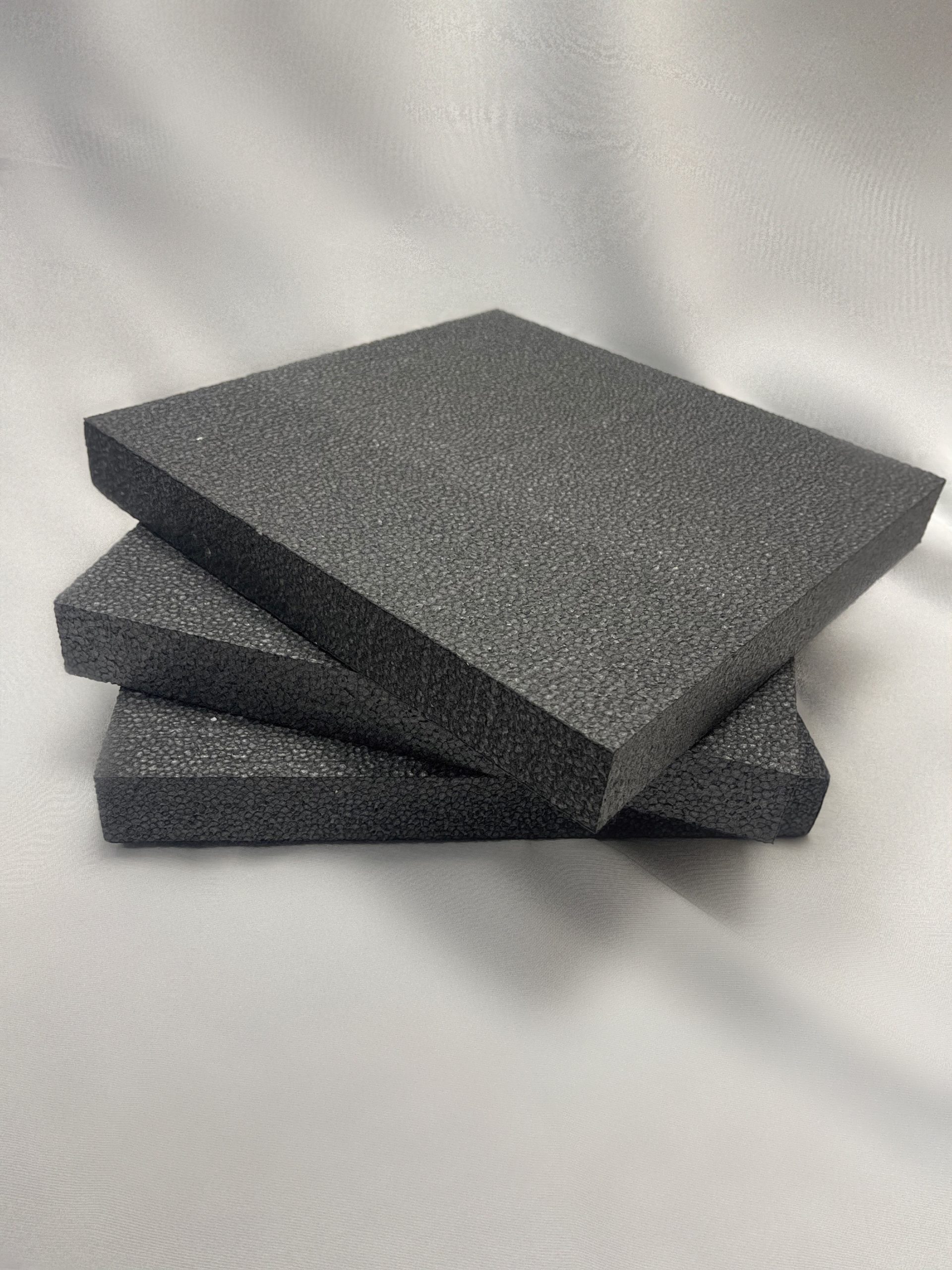Could Geofoam save a community? It possibly might but you are probably wondering how. We recently enjoyed a mental exercise: would the use of our Geofoam product might be beneficial in deterring damage from acts of nature? Forces like hurricanes, heavy rains and the like have recently been topics of interest in the news; how might we help?
Geofoam, with a little help from elasticized geosynthetics could protect levees, sidewalls, embankments, rail and road beds against hurricanes, earthquakes and tsunamis, as well as other natural disasters. Mother Nature seems to be producing more violent storms, and are increasing in number, small and large worldwide and seem to be part of life. Geofoam and other geosynthetics can’t supply the complete solution to saving lives, preventing disaster or the destruction of property, but it can help. In the case of the New Orleans Levee system (built in the 1930’s) failing in 2005’s Katrina, Geofoam wasn’t included in the upgrading that has occurred for decades prior to the nation’s greatest natural disaster ever.
Coastal areas, underground pipelines, nuclear power plants, refineries, fault-line areas and anywhere a natural disaster can occur is where Geofoam can be utilized. The field of geotechnical engineering study has been occurring since man tried to move outside of the cave and create domestic structures. Of course, no home constructed by man could outperform a cave, that is if you discount flooding.
Early man learned over time that structure improvements were a critical part of construction. They used the strongest materials to thwart the storms, but to little avail until things got serious, and they built with stone.
We’ve come a long way from that point, and much has been learned. However, study continues and one day systems will be defined that help to minimize the damage and loss of life natural disasters generate.
One day we’ll have structures that are impermeable and impervious to the forces of nature. Until that day arrives, we must learn all we can, become better prepared for the inevitable, and focus on safety as a global concern. Geofoam and geosynthetics can contribute quite a lot to enhancing soil stability, foundation soundness and lower cost construction.
I’ve been doing my best these past several months to identify the value of Geofoam, and its multitude of uses. Geofoam is a tremendous product to be used in many applications and provides strength and durability when utilized properly in retaining wall, levee, roadbed, and other commercial construction projects. Geofoam provides the solution to unstable soils, shifting, and pressure from all directions.
A Few Years Back, in New Orleans
It’s hard to believe it is more than 10 years since the disaster in Louisiana known as Katrina. Hurricane Katrina’s extensive damage and loss of life could have been lessened had their levee system been brought up to date. There’ loads of evidence that the Army Corps of Engineers, the responsible constructor has continually faced budgetary restrictions, time pressures, and often the butt of jokes since the disaster, although the truth didn’t reveal itself immediately. Although fingers pointed in several directions as to the root cause of the city flooding, it boils down to lack of expertise, the truth and geosynthetics.
This taken from the WSWS.org website:
The levees were originally built with an armoring consisting solely of Bermuda grass, which was later deemed insufficient; it is to be replaced by a more complex system of plastic matting anchored to the levee and then covered in grass. Indications are that this armoring will now not be installed until after the levees have been raised. While the Flood Protection Authority for the east bank has directed the Corps of Engineers to use the more robust grass-and-mat armoring system on its levees, its counterpart on the west bank has challenged the corps’ plans to use this system on its portion, preferring instead the cheaper and less effective Bermuda grass armoring. “On our side of the river, it makes sense to raise the levee, rather than installing the enhanced turf matting that needs to be picked up in a few years, with all that money wasted,” authority president Susan Maclay told the Times Picayune .
Note the statement; the levees need to be raised. Yes, they are sinking, and there is pressure to have them raised (several feet) by the time for the National Flood Insurance recertification in 2025. Truth is stranger than fiction.
As stated by other experts regarding the levee failures can be found online, as evidenced by the citation above.
While Geofoam didn’t exist in the 1930’s when the levee system was first constructed, had they been updated with modern engineering technologies like Geofoam and geosynthetics, things could have been different. The poor design of the pre-Katrina levee system, installed piecemeal over the course of many decades, led to their breach in 2005, resulting in catastrophic flooding in over 80 percent of the city. The faulty design was, in large part, due to extreme funding pressures—improvements to the system planned after Hurricane Betsy in 1965 were still uncompleted when Hurricane Katrina hit.
Unfortunately, the outdated and ineffective levee system in New Orleans has been discussed, analyzed, dissected, cursed at, litigated and decried since they were first built in the founding of the settlement in 1718, and subsequently repaired and replaced, updated and reconfigured, as depicted from the following historical statement:
“The settlement was also prone to periodic flooding by the Mississippi River (between April and August), and flooding and wind damage from hurricanes between June and October. Added to this was abysmally poor drainage, created by unfavorable topography, lying just a few feet above sea level on the deltaic plain of the Mississippi River, which is settling at a rate of between 2 and 10 feet (ft) per century. The tendency for flooding during late spring and summer runoff came to characterize the settlement. The natural swamps north of the original city were referred to as “back swamps” in the oldest maps, and “cypress swamps” on maps made after 1816. During the steamboat era (post 1810), New Orleans emerged as the major trans-shipment center for river borne to sea-borne commerce, vice-versa, and as a major port of immigration.”
What Have We Learned from Hurricane Katrina?
Flooding of the New Orleans Area by Hurricanes strike the Louisiana Coast with a mean frequency of two every three years (Kolb and Saucier, 1982). Since 1759, 172 hurricanes have struck southern Louisiana (Shallat, 2000). Of these, 38 have caused flooding in New Orleans, usually via Lake Pontchartrain. Some of the more notable events have included: 1812, 1831, 1860, 1893, 1915, 1940, 1947, 1965, 1969, and 2005.

Woulda’, Coulda’, Shoulda’
We know from history that the drainage canal systems, the pumping stations failures and the shifting soils of the outdated levee system all failed, creating the costliest natural disaster in US history.
The 700+-page report was funded with $230,000 from the National Science Foundation, another $50,000 from UC Berkeley’s Center for Technology Research in the Interest of Society (CITRIS), and the donated time of 36 professional engineers and scientists from around the nation. The team studied every stretch of the levee system, either on the ground or from the air, conducted soil tests and ran computer simulations.
Its results differ from those of many previous reports, in particular, that of the Corps’ own Interagency Performance Evaluation Taskforce (IPET). According to Seed [head of investigation at UC Berkley], the Corps always has maintained that the levees breached because they were overtopped by an unexpectedly high storm surge.
“These levees were not overtopped, they failed, primarily as a result of human error,” Seed said. ” The hurricane wasn’t much bigger than the levees were designed for.”
“One of our major findings is that the levee system protecting New Orleans was defective as a result of dysfunctional organizations,” emphasized report coauthor Bob Bea, UC Berkeley professor of civil and environmental engineering. “The Corps needs to be modernized, and federal and state oversight of flood control restructured because they can’t build a safe levee with current processes.”
Had a system of compressible inclusion been utilized, the pumping stations could have remained operational (these pumping stations were positioned between sea-level and below) because they operated on their own power. It’s a system utilizing an elasticized geosynthetic panel and Geofoam composition, used against a rigid earth retaining like a levee. Compressible inclusion is the use of product that is compressible at least on one side. It is utilized against a rigid wall construction in most cases. However, it is not as well-known solution as is traditional load-bearing walls are constructed,
By using such a method, the drainage component (included in the construction of such a method) would have enabled a controlled flow of water, as the levee would have held. Within the system is a gas and water membrane covering a compressible Geofoam structure. Rather than the loss of life, displacement of tens of thousands of people, and more than $1.25 Billion in property, had the Army Corps of Engineers mandated modern levee construction and flood control, history would have been more kind.
The following excerpt should lend credence to the belief that more could have been done had they been updated with current soil and engineering technology.

“The analysis or design of any geotechnical structure (retaining wall, unsupported slope, foundation) is fundamentally based on the need to prevent “failure” (the Limit State) in the broadest sense of the word (i.e. loss of function) by satisfying one equation:
Resistance (Capacity)> Loads (Demand)
The extent to which resistance of a structure exceeds the loads applied to it is “safety” and this can be incorporated to the required or desired level using the traditional Allowable Stress Design (ASD)/Working Stress Design (WSD) approach of the more modern Load-and Resistance Factor (LRFD)/Ultimate Strength Design (USD) approach.
Historically, civil engineers have been educated to satisfy Eq.1 in the majority of cases by increasing the left-hand or “resistance” side of the equation. The loads, generally dictated by nature either directly or indirectly, are generally accepted as is and structural material is added to the structure so that Eq.1 is satisfied from both a stiffness (Serviceability Limit State, SLS) and strength (Ultimate Limit State, ULS) perspective.
While this traditional approach has and continues to serve the profession well, it is important to note that it is not the only way to satisfy Eq.1. Specifically, the right-hand or “load” side of the equation can be reduced. Alternatively, there can also be some combination of load reduction and resistance increase. Regardless of the specifics, it is worth noting that the concept of load reduction works particularly well for geotechnical structures because of the many problem categories, especially those involving earth-retaining structures and unsupported slopes, a significant portion of the design loads comes from the mass of the soil itself under gravity or seismic acceleration. Therefore, a potential alternative earth-retaining structure development is to develop technologies where loads are reduced as part of an overall strategy to satisfy Eq.1.
In other words, there is more than one way to save a city. I am not pretending that one of the alternative designs listed containing the papers’ excerpt would have prevented the levee collapse, causing the pumping stations to fail and ultimately washing away a great part of New Orleans. Those with the “expertise and responsibility” should have known better.”
Did Congress Conceal the Truth?
The complete truth didn’t come out about the breached levees in New Orleans for about 9 months after the fact because they didn’t want to tarnish the credibility of the Army Corps of Engineers. The above video clearly shows how and why the city flooded.
I am saying that most believe the levee system at the time was sorely outdated. As the University of Berkley, California determined, the major error was “human.” Designed and built by the Corps, funded by not only federal but state and local public entities, and managed by the Levee Boards, it’s no wonder they never got the proper attention and singular importance. Inadequate engineering and lack of proper funding and the lack of cooperation, in the end, the crux of the failure. Slow response by the federal government was evident, and created a tremendous amount of angst from the local population, and the nation and world at large. Then cover up the truth about the failure’s cause merely added more distrust of the government.
While I do not infer that any such a system could have saved the Sendai, Japan, or Maule, Chile, or any of the other tsunamis of the past decade or so, some of the devastation could have been lessened. By implementing structural reinforcement via Geofoam and/or geosynthetics to provide controlled yielding (compressible inclusion), there may have been less lives lost and fewer of the tens of thousands of buildings destroyed.
This again from WSWS.org:
Ten years after Hurricane Katrina, the greatest civil engineering disaster in American history, the maintenance of New Orleans’ levee system is still in disarray. Billions and billions of dollars are routinely handed out to the financial industry as a matter of routine, but a levee system which protects a major metropolitan area of 1.1 million residents, whose failure resulted in 1,464 deaths and the flooding of 80 percent of the city in 2005, is forced to scrape by.
Could Geofoam save a community? We’ll report on more natural disasters and the use of Geofoam and geosynthetics in the near future. We are exploring more destruction on a massive scale, and the possibilities that using Geofoam and/or geosynthetics could have played a part in minimizing loss. It boils down (as it usually does) to the human interaction. We are living in the greatest technological age, and we are learning at an astronomic level about every conceivable topic.
The more we all learn why things happen the way they do has so much to do with the human element. Our “superior” understanding of all things is sometimes a bit embarrassing. And shameful.







